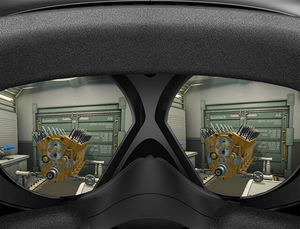Blog Information
- Posted By : esimtech esimtech
- Posted On : Oct 08, 2023
- Comments : 1
- Views : 787
- Category : General
- Description : The Device Virtual Assembly Simulator (DVAS) is a cutting-edge virtual reality (VR) application revolutionizing the manufacturing industry.
Overview
The Device Virtual Assembly Simulator (DVAS) is a cutting-edge virtual reality (VR) application revolutionizing the manufacturing industry. It offers manufacturers the ability to replicate and fine-tune assembly processes virtually, leading to enhanced efficiency, reduced costs, and superior product quality. This article delves into the concept of DVAS, its significance, operational mechanisms, advantages, and its profound impact on manufacturing.

Why DVAS is Crucial for the Manufacturing Sector
DVAS is a computer-based system that leverages virtual reality and simulation technologies to replicate assembly operations. Manufacturers can create virtual prototypes of equipment or products, allowing them to simulate assembly, disassembly, and maintenance processes. Users interact with virtual objects using specialized VR equipment such as headsets and motion controllers, resulting in a highly immersive experience.
How DVAS Operates
DVAS seamlessly integrates multiple technologies to deliver a unified virtual assembly experience:
3D Modeling: Manufacturers initiate the process by developing 3D models of their equipment or products using Computer-Aided Design (CAD) software. These digital models serve as the foundation for the virtual assembly simulation.
Physics Simulation: DVAS employs physics-based techniques to simulate the physical behavior of objects in a virtual environment. Factors like gravity, collisions, and interlocking systems are meticulously replicated. This ensures the realism and accuracy of the assembly process.
Virtual Environment: The DVAS recreates actual manufacturing facilities within a virtual environment, complete with workstations, tools, and other components essential for assembly. Users can navigate and interact with this virtual space using specialized VR devices.
Assembly Process: Manufacturers engage with virtual components using motion controllers to virtually assemble equipment or products. The system tracks users' movements and gestures, allowing them to manipulate virtual objects as if they were physically assembling them. This immersive experience fosters realism.
Real-time Feedback: DVAS provides real-time feedback during the assembly process. Visual indicators, tactile feedback, or audio signals guide users, ensuring adherence to correct assembly methods. This feedback aids users in analyzing and optimizing their assembly procedures for enhanced efficiency.
Disassembly and Maintenance: In addition to assembly, DVAS supports virtual disassembly and maintenance activities. Users can practice and refine their disassembly, maintenance, and reassembly skills without risking damage to real-world objects or equipment.
Iterative Refinement: Manufacturers can iterate and refine the assembly process within the virtual environment using DVAS. This enables early detection and correction of issues or inefficiencies, optimizing the assembly process before actual manufacturing. Such iterative refinement saves time, reduces costs, and enhances overall product quality.

Benefits of DVAS
Improved Efficiency: DVAS eliminates the need for physical prototypes and reduces trial-and-error assembly, allowing manufacturers to identify and rectify issues early in the design phase, thus streamlining the assembly process and shortening time-to-market.
Cost Reduction: Traditional assembly methods can be costly due to physical prototypes, material waste, and rework. DVAS detects and rectifies errors online, reducing the need for physical iterations and lowering costs.
Enhanced Product Quality: DVAS enables comprehensive evaluation of the assembly process, ensuring precise component fit and intended performance. This results in improved product quality and customer satisfaction.
Training and Skill Development: DVAS provides a safe training environment for assembly line workers. New personnel can learn and practice assembly techniques without risking damage to products or equipment. It also facilitates skill development and evaluation for continual improvement.
Design Optimization: DVAS identifies design defects or inefficiencies early on, allowing designers to optimize product design for improved manufacturability and reduced production costs.
Data Analytics: DVAS records and analyzes valuable data during the virtual assembly process. This data can be used to enhance overall production processes, providing insights into productivity, identifying bottlenecks, and optimizing assembly line layouts.
Future Prospects and Challenges
DVAS holds immense potential for the future of manufacturing. As VR technology advances, the simulation experience will become increasingly realistic. Integration with artificial intelligence and machine learning algorithms may enable the system to provide intelligent suggestions and automate repetitive processes.
However, challenges such as the initial setup cost and ensuring the accuracy of virtual simulations compared to real-world processes must be addressed through collaboration among technology developers, manufacturers, and researchers.
In Summary
The Device Virtual Assembly Simulator (DVAS) is a pivotal innovation in manufacturing, employing virtual reality and simulation technology to enhance efficiency, reduce costs, and improve product quality. As technology continues to evolve, DVAS will play a vital role in shaping the future of manufacturing, enabling companies to streamline processes, train their workforce effectively, and achieve higher levels of efficiency and competitiveness.
